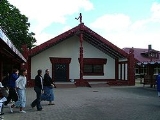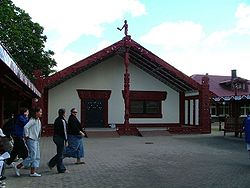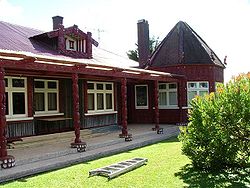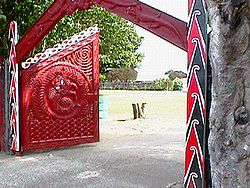
Turangawaewae
Encyclopedia
Turangawaewae Marae is a very significant marae
of the Māori people of New Zealand
and is the headquarters for the Māori King Movement
(Te Kingitanga). Located in the town of Ngāruawāhia
in the Waikato
region of the North Island
, it is the official residence and reception centre of the head of the Kingitanga (until her death on the 15 August 2006, Te Arikinui Dame Te Atairangikaahu
, the sixth Māori monarch). She was succeeded by her eldest son, Tuheitia Paki
. The name Turangawaewae means a place to stand (turanga - stand or position; waewae - leg or foot).
 On August 11, 1921, members of the Ngati Tamaoho hapu under the leadership of the late Princess Te Puea Herangi, an aunt of the recently deceased Māori Queen, left Te Paina (Mercer) on the Roose Shipping Co. barge and arrived the next day at Ngaruawahia on the 12th. Work on the complex began by clearing swampy land overgrown with scrub and blackberry vines, including an area that had been used recently as a rubbish dump.
On August 11, 1921, members of the Ngati Tamaoho hapu under the leadership of the late Princess Te Puea Herangi, an aunt of the recently deceased Māori Queen, left Te Paina (Mercer) on the Roose Shipping Co. barge and arrived the next day at Ngaruawahia on the 12th. Work on the complex began by clearing swampy land overgrown with scrub and blackberry vines, including an area that had been used recently as a rubbish dump.
The marae's buildings include the carved Mahinarangi meeting house, built in 1929, and next to it, Turongo House, the Māori King or Queen's official residence, built in 1938. The two houses are named after Mahinarangi, an East Coast "princess", and her husband Turongo, a Tainui
chief. The link this marriage formed between the two tribal regions was highlighted by Sir Apirana Ngata
when Te Puea was debating a name for the house. Ngata and his tribe, Ngati Porou
, had contributed thousands of pounds in funding by supporting performances by Te Puea's concert party when it travelled the East Coast region. In addition he sent expert carvers and weavers to assist with the construction of the building. To commemorate this he asked that the meeting house be named after the East Coast ancestress to salute the ancient link and the modern day koha
(gift) Ngati Porou had provided.
 The death and suffering of local Māori caused by the Influenza pandemic of 1918 still remained fresh in the memory of Turangawaewae residents and Te Puea's original vision for Mahinarangi was to be a hospital for the Māori community so they could receive treatment in a traditional manner. However the Ministry of Health would not grant the necessary permits for it to be used this way. Thus the building was made into a reception hall of sorts and has hosted many foreign dignitaries. A visiting New Zealand prime minister commented at the conclusion of a visit with King Koroki that the house was a fine sitting room for a King. This comment gave Te Puea an idea: what use is a sitting room if there isn't a house to entertain visiting guests properly?
The death and suffering of local Māori caused by the Influenza pandemic of 1918 still remained fresh in the memory of Turangawaewae residents and Te Puea's original vision for Mahinarangi was to be a hospital for the Māori community so they could receive treatment in a traditional manner. However the Ministry of Health would not grant the necessary permits for it to be used this way. Thus the building was made into a reception hall of sorts and has hosted many foreign dignitaries. A visiting New Zealand prime minister commented at the conclusion of a visit with King Koroki that the house was a fine sitting room for a King. This comment gave Te Puea an idea: what use is a sitting room if there isn't a house to entertain visiting guests properly?
 Thus Turongo house was born. This exquisitely carved home was the brain child of Te Puea. Having noticed a home in Hamilton with a hexagonal tower in the corner she came up with a blueprint that incorporated both Māori and European architectural styles. The house interior and exterior surfaces have been carved extensively and have incorporated many symbols important to the Kingitanga movement. A 7 sided tower in the corner represents the 7 initial waka that, according to tradition, brought the Māori people to their new home of Aotearoa. It also has some unique features such as untreated ponga log cladding on the exterior walls. There are also two pataka (store houses) acting as dormer windows on the roof and storing important taonga (treasures) of the Kingitanga. Each one represents the Māori and European influence on the local people. The modern day house contains magnificent reception rooms, dining rooms and kitchens that are suitable for the Arikinui to host guests in a distinctly Māori fashion.
Thus Turongo house was born. This exquisitely carved home was the brain child of Te Puea. Having noticed a home in Hamilton with a hexagonal tower in the corner she came up with a blueprint that incorporated both Māori and European architectural styles. The house interior and exterior surfaces have been carved extensively and have incorporated many symbols important to the Kingitanga movement. A 7 sided tower in the corner represents the 7 initial waka that, according to tradition, brought the Māori people to their new home of Aotearoa. It also has some unique features such as untreated ponga log cladding on the exterior walls. There are also two pataka (store houses) acting as dormer windows on the roof and storing important taonga (treasures) of the Kingitanga. Each one represents the Māori and European influence on the local people. The modern day house contains magnificent reception rooms, dining rooms and kitchens that are suitable for the Arikinui to host guests in a distinctly Māori fashion.
Some of Te Puea's main goals for the movement were to increase the mana or prestige of the Kingitanga and its figurehead the Arikinui by:
 Turangawaewae, along with the Kingitanga movement and the office of the Arikinui, has become a key institution to showcase Māoridom not only in New Zealand but the world. Countless world leaders including Nelson Mandela, Queen Elizabeth II and many of her children have paid courtesy visits to Te Arikinui Dame Te Atairangikaahu and the people of the Kingitanga. Under the leadership of Te Puea strong relationships had been established with the Polynesian royal families of the Cook Islands, Samoa and Tonga. As a result, during the annual Koroneihana (coronation) festivities, representatives of the Polynesian royal houses including the late Queen Salote of Tonga and many of her descendants have made many visits and gifted highly prized taonga to the Arikinui which are now housed in the dual pataka of Turongo.
Turangawaewae, along with the Kingitanga movement and the office of the Arikinui, has become a key institution to showcase Māoridom not only in New Zealand but the world. Countless world leaders including Nelson Mandela, Queen Elizabeth II and many of her children have paid courtesy visits to Te Arikinui Dame Te Atairangikaahu and the people of the Kingitanga. Under the leadership of Te Puea strong relationships had been established with the Polynesian royal families of the Cook Islands, Samoa and Tonga. As a result, during the annual Koroneihana (coronation) festivities, representatives of the Polynesian royal houses including the late Queen Salote of Tonga and many of her descendants have made many visits and gifted highly prized taonga to the Arikinui which are now housed in the dual pataka of Turongo.
Turangawaewae Marae and its unique buildings are a physical representation of the determination of the Kingitanga to not only survive the last 200 years of turmoil, but to prosper and flourish under the leadership of monumental leaders like Te Puea and Te Arikinui Dame Te Atairangikaahu.
Marae
A marae malae , malae , is a communal or sacred place which serves religious and social purposes in Polynesian societies...
of the Māori people of New Zealand
New Zealand
New Zealand is an island country in the south-western Pacific Ocean comprising two main landmasses and numerous smaller islands. The country is situated some east of Australia across the Tasman Sea, and roughly south of the Pacific island nations of New Caledonia, Fiji, and Tonga...
and is the headquarters for the Māori King Movement
Maori King Movement
The Māori King Movement or Kīngitanga is a movement that arose among some of the Māori tribes of New Zealand in the central North Island ,in the 1850s, to establish a role similar in status to that of the monarch of the colonising people, the British, as a way of halting the alienation of Māori land...
(Te Kingitanga). Located in the town of Ngāruawāhia
Ngaruawahia
Ngāruawāhia is a town in the Waikato region of the North Island of New Zealand. It is located 20 km north-west of Hamilton at the confluence of the Waikato and Waipa Rivers...
in the Waikato
Waikato
The Waikato Region is a local government region of the upper North Island of New Zealand. It covers the Waikato, Hauraki, Coromandel Peninsula, the northern King Country, much of the Taupo District, and parts of Rotorua District...
region of the North Island
North Island
The North Island is one of the two main islands of New Zealand, separated from the much less populous South Island by Cook Strait. The island is in area, making it the world's 14th-largest island...
, it is the official residence and reception centre of the head of the Kingitanga (until her death on the 15 August 2006, Te Arikinui Dame Te Atairangikaahu
Te Atairangikaahu
Dame Te Atairangikaahu, ONZ, DBE, OStJ was the Māori queen for 40 years, the longest reign of any Māori monarch. Her full name and title was Te Arikinui Te Atairangikaahu...
, the sixth Māori monarch). She was succeeded by her eldest son, Tuheitia Paki
Tuheitia Paki
Tuheitia Paki, KStJ is the current Māori King in New Zealand. He is the eldest son of the previous Māori monarch, Dame Te Atairangikaahu, and was announced as her successor and crowned on the same day as her tangihanga took place, on 21 August 2006...
. The name Turangawaewae means a place to stand (turanga - stand or position; waewae - leg or foot).

The marae's buildings include the carved Mahinarangi meeting house, built in 1929, and next to it, Turongo House, the Māori King or Queen's official residence, built in 1938. The two houses are named after Mahinarangi, an East Coast "princess", and her husband Turongo, a Tainui
Tainui
Tainui is a tribal waka confederation of New Zealand Māori iwi. The Tainui confederation comprises four principal related Māori iwi of the central North Island of New Zealand: Hauraki, Ngāti Maniapoto, Ngāti Raukawa and Waikato...
chief. The link this marriage formed between the two tribal regions was highlighted by Sir Apirana Ngata
Apirana Ngata
Sir Apirana Turupa Ngata was a prominent New Zealand politician and lawyer. He has often been described as the foremost Māori politician to have ever served in Parliament, and is also known for his work in promoting and protecting Māori culture and language.-Early life:One of 15 children, Ngata...
when Te Puea was debating a name for the house. Ngata and his tribe, Ngati Porou
Ngati Porou
Ngāti Porou is a Māori iwi traditionally located in the East Cape and Gisborne regions of the North Island of New Zealand. Ngāti Porou has the second-largest affiliation of any iwi in New Zealand, with 71,910 registered members in 2006...
, had contributed thousands of pounds in funding by supporting performances by Te Puea's concert party when it travelled the East Coast region. In addition he sent expert carvers and weavers to assist with the construction of the building. To commemorate this he asked that the meeting house be named after the East Coast ancestress to salute the ancient link and the modern day koha
Koha (custom)
Koha is a New Zealand Māori custom which can be translated as gift, present, offering, donation or contribution.-Traditional usage:Koha is an example of the reciprocity which is a common feature of much Māori tradition, and often involves the giving of gifts by visitors to a host marae...
(gift) Ngati Porou had provided.


Some of Te Puea's main goals for the movement were to increase the mana or prestige of the Kingitanga and its figurehead the Arikinui by:
- Raising the standards of health, housing and employment of the people
- Establishing a national marae complex at Ngaruawahia (Turangawaewae Marae) that would be a centre of Māori culture and politics, thus creating a strong sense of community, pride and more importantly, mana amongst the Kingitanga.

Turangawaewae Marae and its unique buildings are a physical representation of the determination of the Kingitanga to not only survive the last 200 years of turmoil, but to prosper and flourish under the leadership of monumental leaders like Te Puea and Te Arikinui Dame Te Atairangikaahu.

